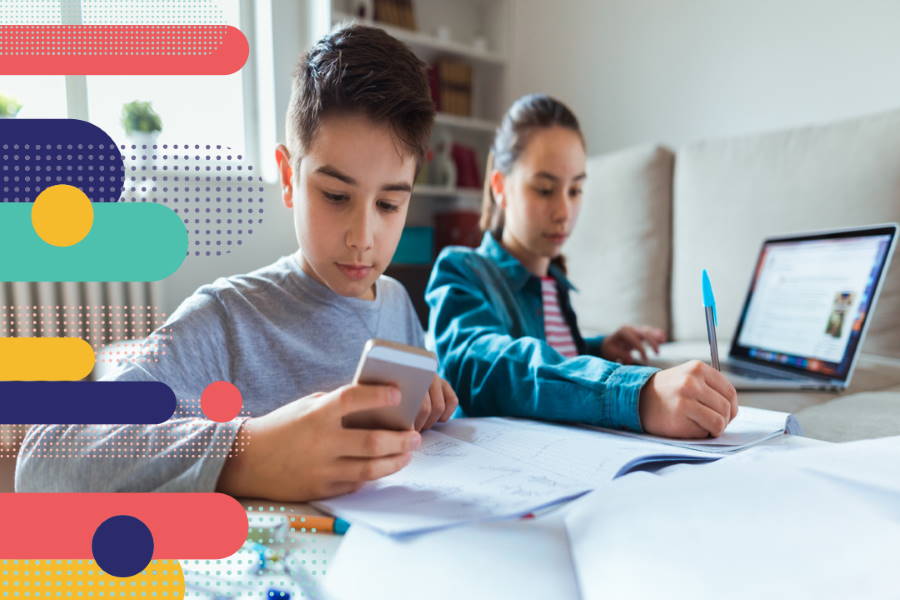Many schools have closed due to coronavirus and COVID-19 mitigation attempts, and many more are sure to follow. Some parents are keeping kids home out of caution. The result: Classrooms are moving online in droves, creating a whole new set of teaching challenges. Julie, TeacherVision's Head of Content and Curriculum, shares tips and strategies for making the most of online learning during this trying time for teachers, students, and parents.

How do we continue teaching right now?
This is the question that 46,600 members of the Educator Temporary School Closure for Online Learning Facebook group are asking this morning as schools across the nation shut their doors and attempt to shift learning online. According to an analysis from Education Week, as of March 12, “at least 10,600 schools have been closed or are scheduled to close'' because of Coronavirus.
While policy decisions vary state-to-state - some states are extending Spring break, while others are scrambling to plan distance learning programs - what remains consistent for all teachers is that this is unprecedented. There is no roadmap for what we should do. We can only do our best, and adapt to the situation as it evolves.
In this blog post, we will share:
- Teaching tips
- Our favorite online tools
- Online learning best practices
- A distance learning model that works
Teaching Tips
Survey Parents and Learn What Tools They Have At Home
If students don’t have access to a computer or the internet, it will be impossible to teach online. To solve this problem, some schools are allowing families to borrow computers and hotspots. Comcast is offering two months of free internet access for new customers, which could help students access online learning resources.
If students do have access, find out what the options are: tablets, computers, etc. Ask parents how much bandwidth they have to supervise students’ learning, as many parents will still have to go into work or will work from home. This will help you determine the online learning structure that will work best.
If you haven’t created a survey before, we recommend using Google Forms or Survey Monkey. Both tools are user-friendly and allow you to quickly send out your survey and gather responses.
Decide On A Learning Structure
One of the biggest online learning challenges is how to structure and deliver instruction. To keep things simple, it may be helpful to set up a regular schedule for instructional time and communicate explicitly about when lessons will take place, how to access them, what the expectations are, etc.
Here are some questions to consider:
- Will students work on their own at their own pace?
- Will they receive a list of assignments each morning and complete them as they go?
- Will students learn at the same time?
- Will they attend their classes via video conferencing and have homework to complete when classes are over?
There are two different models of online instruction that you can consider here:
Asyncronous: Students learn at different times. They receive a list of assignments each morning and complete them throughout the day. Teachers rely on learning management systems like Google Classroom and Schoology to post assignments, collect homework, and communicate with students.
Synchronous: Students learn at the same time. Students attend classes via video conferencing platforms like Zoom and Google Hangouts. They can ask questions and after classes are over they complete homework as usual, which they submit via email or learning management system.
There are pros and cons to both systems, and from my experience, the asynchronous model is more effective with older students. Many teachers will use a combination of both.
Use Tools Students Are Familiar With or Only Introduce 3 New Tools
The process of learning at home will be new for most of our students. Not only are students adjusting to this change, they are also wondering when they will be able to go back to school. Many students are anxious right now, and asking them to learn how to use new software, apps, and online systems is going to be overwhelming. If all possible, rely on the technology tools they are already familiar with. For example, in my classroom I used Padlet, Class Dojo, and CommonLit frequently. I would continue to use these tools during school closures as students already know how they work.
If you don’t use technology consistently in your classroom, try not to use more than three tools during school closure. I would recommend that you use a video conferencing tool so you can either teach your classes live, invite students to an “office hours,” where they can video conference with you and ask questions, or check in daily for attendance and a morning meeting.
Rely On Video Conferencing For Attendance and Live Classes
Video conferencing will allow you to meet with your students, whether you choose to teach a live class, make yourself available for questions or take attendance and make a plan with your students for the day. Some video conferencing tools you can consider are: Zoom, Google Hangouts, and Microsoft Teams. You can share your screen with students and teach them how to use the online tools and resources that are needed until schools can reopen.
Be Comfortable With Being Uncomfortable
It is easier said than done, but because this happened so quickly and is uncharted territory, it is going to feel uncomfortable. Whenever you are working with technology there is the possibility that it won’t work. A computer screen will freeze, a student won’t remember their password, and you won’t know what you don’t know. This is a good time to rely on each other. There are many Facebook groups for educators where teachers are sharing resources and ideas. Do the best that you can, but take breaks. Set boundaries for when you will make yourself available to students. Step away from the computer screen. Trust that you are doing the best that you can.
Our Favorite Tools
There are so many different technology tools. It can feel overwhelming to decide what tool to use. These are 5 online tools we highly recommend for enhancing students' learning.
Online Learning Best Practices
You will face challenges that are unique to an online teaching environment if your school closes and shifts to a distance learning model. Here is our list of best practices for online teaching.
A Distance Learning Model That Works
Lisa Koplik, an elementary teacher and TeacherVision Advisory board member, shares that her district, Wakefield Public Schools, already had a distance learning model in place for snow days called the Learn Anywhere Project. The teachers are using Google Documents in order to share work with their students.
Here's how it works:
- Each grade level has its own Google Document.
- Google Documents are updated daily with new assignments.
- Students do 20-30 minutes of math, reading and writing.
Lisa also relies on her favorite tools like iReady, Prodigy, and Readworks to support her students to keep learning outside of the classroom. While the system has worked well in the past, it isn’t without its challenges.
“The difficult part has been considering the needs of kids on IEPs if the assignments aren't differentiated, and ensuring follow through from the few students who simply won't do the work and the parents don’t enforce it,” Lisa says.
While this is a challenging time, no one is more resilient than teachers. To help support everyone, we are offering Your Teacher Self-Care Workbook for free. Use the tips and exercises for six ways to alleviate stress and take care of yourself.
How are you managing online learning during school closures? Share with us on Instagram, Facebook, Twitter, and Pinterest.
Julie Mason is the Head of Content and Curriculum for TeacherVision. She brings expertise in blended and personalized learning, instructional coaching, and curriculum design to the role. She was a middle and high school English teacher for eight years and most recently taught at Dana Hall, an all-girls school in Wellesley, MA. She was a blended and personalized learning instructional coach for K-12 teachers at BetterLesson for two years, and she has presented at The National Principals Conference, ISTE, and ASCD where she shared her expertise on how instructional coaching builds teacher capacity in K-12 schools. She has extensive experience designing and facilitating professional development for teachers, and she oversees the TeacherVision advisory board.










